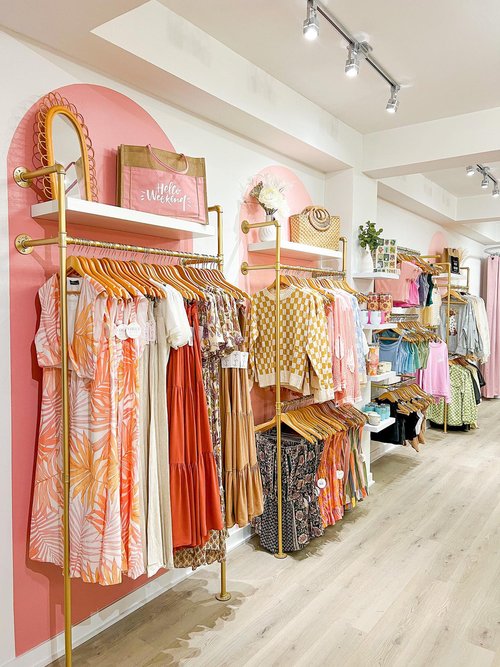Lasting Fashion: Exactly How Eco-Friendly Clothing Is Shaping the Future of Style
As the apparel industry deals with boosting analysis over its ecological impact, the surge of lasting style offers an appealing choice that lines up style with ecological responsibility. Using innovative materials such as plant-based textiles and recycled fibers, together with advanced methods like digital and 3D printing, designers are redefining what it means to be trendy in the modern-day age. Simultaneously, the expanding appeal of upcycling and second hand society is cultivating a change in the direction of a round economy. How does this movement really influence the future trajectory of fashion, and what obstacles exist in advance in its prevalent fostering?
Innovative Lasting Materials
As the style industry grapples with its environmental influence, innovative lasting products have arised as a critical remedy for minimizing ecological footprints. These materials not just decrease dependence on fossil fuels however likewise decrease damaging pesticide use and water intake.
In enhancement to plant-based products, developments in biofabrication have caused the growth of lab-grown fabrics. Mycelium natural leather, stemmed from mushroom roots, presents a functional and eco-friendly alternative to pet leather. Its production results in significantly reduced carbon discharges and water usage, making it a much more sustainable option for fashion developers seeking to line up with environmentally friendly practices.
Recycled materials are additionally obtaining traction, with polyester made from recycled plastic containers representing a considerable advancement. This development not only diverts plastic waste from landfills and seas but additionally lowers energy consumption contrasted to generating virgin polyester. With each other, these materials underscore the potential for an extra sustainable apparel industry, paving the way for eco mindful style and production.
Eco-Conscious Production
Building on the developments in lasting materials, the garment industry is also re-evaluating its production procedures to better minimize environmental effect. Key strategies include minimizing water usage, reducing carbon exhausts, and getting rid of harmful chemicals. By adopting closed-loop systems, suppliers aim to reuse water and energy successfully, considerably reducing waste. The assimilation of eco-friendly power resources, such as solar and wind power, right into production facilities additionally reduces reliance on nonrenewable fuel sources.
An additional important facet is the reduction of poisonous chemicals typically utilized in coloring and ending up textiles. Eco-conscious makers are shifting towards plant-based dyes and waterless dyeing innovations, which not just safeguard local ecological communities however likewise enhance employee safety and security. Technologies like electronic printing reduce textile waste and power intake, providing a cleaner choice to traditional methods.
Additionally, openness and traceability have actually ended up being extremely important. With the advancement of blockchain technology, companies can now supply thorough understandings right into their supply chains, making sure ecologically friendly and ethical practices at each action. This openness develops consumer count on and encourages brand names to maintain high sustainability standards. As the need for eco-conscious items grows, producers are obliged to innovate, guaranteeing that the future of style is both lasting and elegant.
The Increase of Upcycling
Upcycling, a transformative practice in sustainable style, includes creatively repurposing thrown out materials right into new, premium items. This ingenious approach not only reduces waste however additionally reduces the demand for raw products, thereby decreasing the environmental influence of clothes manufacturing. By reimagining and reconstructing existing items, developers and fashion brand names are able to infuse creativity into their collections while advertising environmental obligation.

Moreover, the upcycling movement has actually equipped local business and independent designers, who typically lead in development due to their dexterity and creative thinking. By taking advantage of the abundant schedule of extra materials, these entities add to a round economic situation, showing that style can be both lasting and trendy. Via upcycling, the market takes significant strides in the direction of a much more aware and accountable future.
Thrift Society's Impact
The expanding second hand society substantially reshapes the landscape of lasting fashion, highlighting the value of conscious intake. This social change urges customers to accept previously owned clothes, therefore decreasing the need for brand-new garment manufacturing and minimizing ecological impact. Thrift shopping not only extends the lifecycle of clothing yet also decreases the carbon impact related to production, carrying, and disposing of apparel.
A vital aspect of second hand culture is its democratization of style. By offering a large array of styles from various eras at affordable prices, second hand shops make fashion easily accessible to a more comprehensive audience. This access fosters a feeling of individuality and creative thinking, as consumers mix and match one-of-a-kind items to curate personalized closets without contributing to the rapid fashion cycle.
Additionally, second hand society advertises circularity in style, aligning with the concepts of a round economic climate. As more designers and customers welcome second hand culture, the style market is urged to adjust, incorporating lasting methods to fulfill the growing need for eco-conscious alternatives.

Future Trends in Style
Style's development is significantly shaped by technical innovations and sustainability-driven initiatives. As consumers come to be a lot more environmentally aware, the sector is reacting with groundbreaking developments that redefine the future of style. One popular trend is the increase of digital style, where digital garments can be worn in augmented reality settings, considerably reducing fabric waste. This change not just satisfies the Clicking Here digital-savvy consumer but additionally lessens the ecological impact commonly connected with garment manufacturing.
Moreover, the assimilation of blockchain modern technology supplies new possibilities in openness and traceability, enabling customers to verify the sustainability qualifications of their garments. boutique fashion. This ensures liability in supply chains and promotes ethical sourcing practices. 3D printing is yet an additional advancement that assures to transform making procedures by making it possible for on-demand manufacturing, consequently reducing excess supply and waste
Furthermore, the development of bio-fabricated products, such as lab-grown natural leather and plant-based fabrics, provides lasting alternatives to standard products. These developments minimize dependence on animal items and resource-intensive crops. As these technologies grow, they are poised to change the fashion landscape, merging design with sustainability. The future of fashion, consequently, lies in a smooth mix of modern technology, advancement, and environmental duty.
Conclusion
The makeover of the garment industry with sustainable techniques indicates a crucial change towards ecological liability. The combination of cutting-edge products, eco-conscious production methods, and the embracement of upcycling and thrift culture underscores a commitment to reducing ecological impacts. As these methods get momentum, they redefine the sector's story by prioritizing moral and sustainable options. This development not just lines up fashion with ecological sustainability yet likewise establishes a precedent for future patterns concentrated on responsibility and technology.
As the style sector deals with enhancing examination over its environmental browse this site effect, the increase of sustainable style supplies an encouraging choice that aligns design with ecological obligation.As the style sector grapples with its ecological effect, cutting-edge sustainable materials have emerged as an important service for lowering environmental footprints. With each other, these materials highlight the capacity for a more lasting style market, leading the means for ecologically aware layout and production.
Structure on the technologies in lasting materials, the fashion market is likewise re-evaluating its production processes to further minimize ecological effect. boutique fashion.Upcycling, a transformative technique in sustainable style, involves creatively repurposing disposed of materials into new, high-grade items